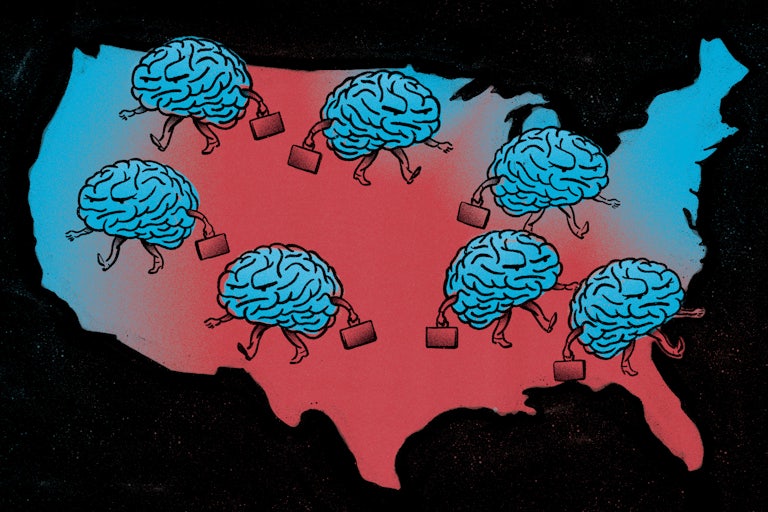
Timothy Noah/
November 22, 2023
SMART MOVES
The Red State Brain Drain Isn’t Coming. It’s Happening Right Now.
As conservative states wage total culture war, college-educated workers—physicians, teachers, professors, and more—are packing their bags.
ILLUSTRATION BY ALEX NABAUMOn Memorial Day weekend in 2022, Kate Arnold and her wife, Caroline Flint, flew from Oklahoma City to Cabo San Lucas for a little R&R. They had five kids, the youngest of them five-year-old twin girls, and demanding jobs as obstetrician-gynecologists. The stresses of all this were mounting. That they were a gay married couple living in a red, socially conservative state was the least of it. Caroline was born in Tulsa, spent much of her childhood in Oklahoma, and was educated at the University of Oklahoma. She cast her first presidential vote for George W. Bush. Kate, the more political of the two, was from Northern California and a lifelong Democrat. But her mother was born in Oklahoma City, and she felt at home there; she’d even given some thought to running for the state legislature.
Kate and Caroline flew down with the twins and their 16-year-old daughter. It says a lot about Kate Arnold that she adopted the three older children while she was attending medical school; the birth mother, whom Kate befriended while volunteering at a home for teenage mothers, was an addict who lost custody.
Arriving in Cabo, Kate and Caroline realized that it had been a very long time—too long— since their last date night. So one evening they ordered the kids room service and went off by themselves to a Taco Night theme dinner. “We sat outside with the little colored flags,” Kate recalled, “and they gave us blankets because it was cold and windy. We hadn’t been sitting for very long when I started saying I wasn’t happy.”
A little more than one week earlier, a disturbed high school student named Salvador Ramos had entered Robb Elementary School in Uvalde, Texas, with an AR-15 rifle and killed 19 children and two adults, injuring 17 more. It was the deadliest school shooting since the Sandy Hook massacre in 2012, and it happened just one state over as Kate and Caroline’s two youngest were about to start school. Two more mass shootings occurred in Oklahoma while they were in Cabo. A man named Michael Louis gunned down, with an AR-15, two doctors, a receptionist, and a patient at the Tulsa offices of his orthopedic surgeon because he was angry that his recent back surgery left him in pain. Then a man named Skyler Buckner killed one person and injured seven others at a Memorial Day festival in Taft, Oklahoma. States with permissive gun laws have a higher rate of mass shootings, and Oklahoma, with some of the most permissive gun laws in the country, has 45 percent more gun deaths per capita than the national average—higher even than in Texas.
That was one reason Kate wasn’t happy.
Another reason was that the state legislature was trying to limit access to contraceptives. In March, the state Senate had voted to require parental consent before a minor could take contraceptives. Kate was chair of the Oklahoma chapter of the American College of Obstetricians and Gynecologists, and she’d lobbied against this change. (The bill later died in the state House of Representatives.)
“You’re just gonna get my nine-year-old birth control without my knowledge?” one state legislator said to her.
“How does your nine-year-old need birth control?” Kate answered. “And yes, if she needs birth control … what’s worse than her coming home pregnant?”
Caroline had reasons to be unhappy, too. One year earlier, Oklahoma’s governor had signed a law barring public schools and charter schools from teaching that “an individual, by virtue of his or her race or sex, bears responsibility for actions committed in the past by other members of the same race or sex.” School boards interpreted this as an invitation to ban any book that touched on race or gender. Among the books targeted in Oklahoma, according to the free-speech organization PEN America, were Narrative of the Life of Frederick Douglass, A Raisin in the Sun, To Kill a Mockingbird, and Their Eyes Were Watching God. “Books are my thing,” Caroline told me. She couldn’t abide the idea that “books would be censored.”
Also, Caroline’s hospital wouldn’t let her perform gender-affirming surgery. The procedure was legal in Oklahoma, but this was a Baptist hospital, and fairly conservative. “I would do surgeries,” Caroline said, “like hysterectomies for patients who are transitioning. And I’d have to have another indication to do it.… I’d have to say, ‘Oh, they also have pain,’” or find some other reason.
Kate was director of women’s health at a large, federally funded nonprofit health center serving low-income patients. It was, she told me, “A job that I loved.” But five months before their Cabo dinner, Kate published an op-ed at a nonprofit Oklahoma news site criticizing state felony prosecutions of women who miscarried after taking drugs during pregnancy. “Anytime you criminalize drug use in pregnancy,” Kate explained to me, the addicts stop going to the hospital, “and you have worse and worse outcomes.”
After the op-ed appeared, somebody phoned Kate’s health center to complain. After that, Kate’s superiors effectively barred her from making public statements about anything. Kate’s boss explained why: The FBI had alerted the center to threats of violence “just for providing birth control.”
After the op-ed appeared, somebody phoned Kate’s health center to complain. After that, Kate’s superiors effectively barred her from making public statements about anything. That irked Kate until her boss explained why: The FBI had contacted the health center to alert them to threats of violence “just for providing birth control.” Did I mention that Oklahoma allows anybody over the age of 21 to carry a loaded firearm in public, open or concealed, without a license?

